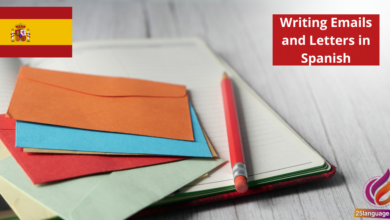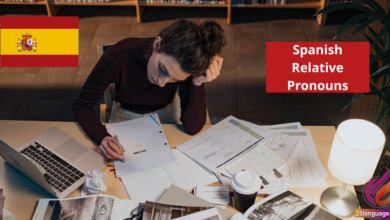How to Express the Future Without the Future Tense

Imagine being able to talk about future plans and events without ever mentioning the future tense! In this lesson, you’ll discover creative ways to express upcoming actions in Spanish using present tense structures, time expressions, and more. this approach not only enhances your fluency but also adds a natural flair to your conversations. Get ready to master essential techniques that will allow you to speak about the future like a native!
Expressing Future intentions Through Other Tenses
In Spanish, future intentions can be expressed using various tenses beyond the straightforward future tense. One commonly used method is to employ the present tense, particularly when referring to planned actions or intentions in the near future. This use of the present tense is prevalent in everyday conversation and emphasizes immediacy. For example, you might say “Voy a comprar un coche mañana.” (I am going to buy a car tomorrow.), where “voy” (I go) is in the present indicative tense. Similar constructions can be made using the verb “ir” (to go), as in “Voy a estudiar esta noche.” (I am going to study tonight.), which also signifies a future intention.
Another way to communicate future intentions is through the use of the simple future tense, which conveys a more distant or less certain intention. This tense typically involves the infinitive form of the verb plus specific endings. For example, in the sentence “Estudiaré para el examen de matemáticas.” (I will study for the math exam.), the verb “estudiar” (to study) is modified by adding the future tense ending “-é” to indicate a future action. Moreover, the conditional tense can express intentions that are conditional upon another action, like “Si tengo tiempo, leería más libros.” (If I have time,I would read more books.). The following table summarizes these different methods of expressing future intentions:
| spanish Example | Rules/Usage | English Translation |
|---|---|---|
| Voy a comprar un coche mañana. | Present tense used for near future intentions. | I am going to buy a car tomorrow. |
| Estudiaré para el examen de matemáticas. | Simple future tense for future actions. | I will study for the math exam. |
| Si tengo tiempo, leería más libros. | Conditional tense for actions dependent on a condition. | If I have time,I would read more books. |
Mastering Future Concepts Without Future Tense
In Spanish, the future can often be expressed without using the conventional future tense by employing various structures such as the present tense, ir a + infinitive, and expressions of time. One common method is to use the present tense to denote future actions, especially when the event is already planned or scheduled. For instance, “Tengo una reunión mañana” translates to “I have a meeting tomorrow.” This construction signifies a future event without relying on the future tense itself. Similarly, you can express future intentions or plans with ir a + infinitive. For example, “Voy a estudiar esta noche” means “I am going to study tonight.” This structure is particularly useful for communicating planned actions.
Another way to convey future meanings in spanish is through time expressions that provide context for future events. Phrases such as “la semana que viene” (next week), “el próximo año” (next year), or “el lunes” (on monday) can be combined with the present tense to indicate future occurrences. Such as, “El próximo año viajo a España” translates to “Next year, I am traveling to Spain.” Let’s summarize these methods in the table below:
| spanish Example | Rule | English Translation |
|---|---|---|
| Tengo una reunión mañana | Present tense for scheduled future events | I have a meeting tomorrow |
| Voy a estudiar esta noche | Ir a + infinitive for planned actions | I am going to study tonight |
| El próximo año viajo a España | Present tense with time expressions | next year, I am traveling to Spain |
creative Strategies for Discussing Future Events
When talking about future events in Spanish, the most common grammatical structure used is the simple future tense. This tense is formed by adding specific endings to the infinitive form of regular verbs. For example, the endings are -é, -ás, -á, -emos, -éis, -án. Here are some examples:
- Yo hablaré – I will talk
- Tú comerás – You will eat
- Nosotros iremos – We will go
In addition to the simple future tense, the ”ir a” construction (to be going to) is also very popular for discussing planned future actions. This construction is made up of the verb “ir” (to go) in the present tense,followed by “a” and the infinitive of the main verb. For example:
- Voy a estudiar – I am going to study
- Vamos a viajar - We are going to travel
- Ella va a cocinar – She is going to cook
| Spanish Example | Grammar Rule | English Translation |
|---|---|---|
| Yo hablaré | Simple future tense (add -é to hablar) | I will talk |
| Tú comerás | Simple future tense (add -ás to comer) | You will eat |
| Voy a estudiar | “Ir a” construction (present tense of ir + a + infinitive) | I am going to study |
| Vamos a viajar | “Ir a” construction | We are going to travel |
Alternatives to Future Tense: A Practical Guide
In Spanish, while the future tense is commonly used to indicate actions that will happen, there are several alternatives that can convey future meaning without relying on the future tense. One of the most frequent methods is using the present tense to describe future events. This construction is especially practical for plans arranged in the near future or scheduled events. Such as: “Salgo mañana a las ocho.” (I leave tomorrow at eight.) and “Vamos al cine esta noche.” (We are going to the cinema tonight.) illustrate this usage effectively.
Another choice is to use the phrase “ir a” followed by an infinitive verb. This structure not only expresses intention but also indicates a planned action. It is similar to using “going to” in English. Here are some examples: “voy a estudiar esta tarde.” (I am going to study this afternoon.) and “ellos van a viajar el próximo mes.” (They are going to travel next month.) This structure is widely used in everyday conversation, making it an essential aspect of practical Spanish.
| Spanish Example | Rule or Phrase | English translation |
|---|---|---|
| Salgo mañana a las ocho. | Present tense for future action | I leave tomorrow at eight. |
| Vamos al cine esta noche. | Present tense for planned events | We are going to the cinema tonight. |
| voy a estudiar esta tarde. | Ir a + infinitive for intention | I am going to study this afternoon. |
| Ellos van a viajar el próximo mes. | Ir a + infinitive for planned action | They are going to travel next month. |
Final Thoughts
hoy hemos explorado formas efectivas de expresar el futuro en español sin recurrir al tiempo futuro. Hemos aprendido a utilizar frases que indican intenciones, como el presente inmediato (voy a ___), además de estructuras como el uso de la expresión “ir a” y las formas del presente simple para hablar sobre eventos programados. Estas herramientas no solo enriquecerán su vocabulario, sino que también les darán confianza a la hora de comunicarse en español.
Recuerden que la práctica es clave para dominar estas estructuras.Les animo a que incorporen estas expresiones en sus conversaciones diarias, tanto habladas como escritas. Piensen en situaciones cotidianas en las que puedan usarlas, ya sea al hacer planes con amigos, al hablar sobre sus aspiraciones, o incluso en la planificación de su próximo viaje.
¡No subestimen el poder de la práctica! cada esfuerzo que hagan por utilizar lo aprendido hoy los acercará más a la fluidez. continúen explorando y experimentando con el idioma, y pronto se sentirán cada vez más cómodos expresando el futuro en español. ¡Ustedes pueden lograrlo!





























